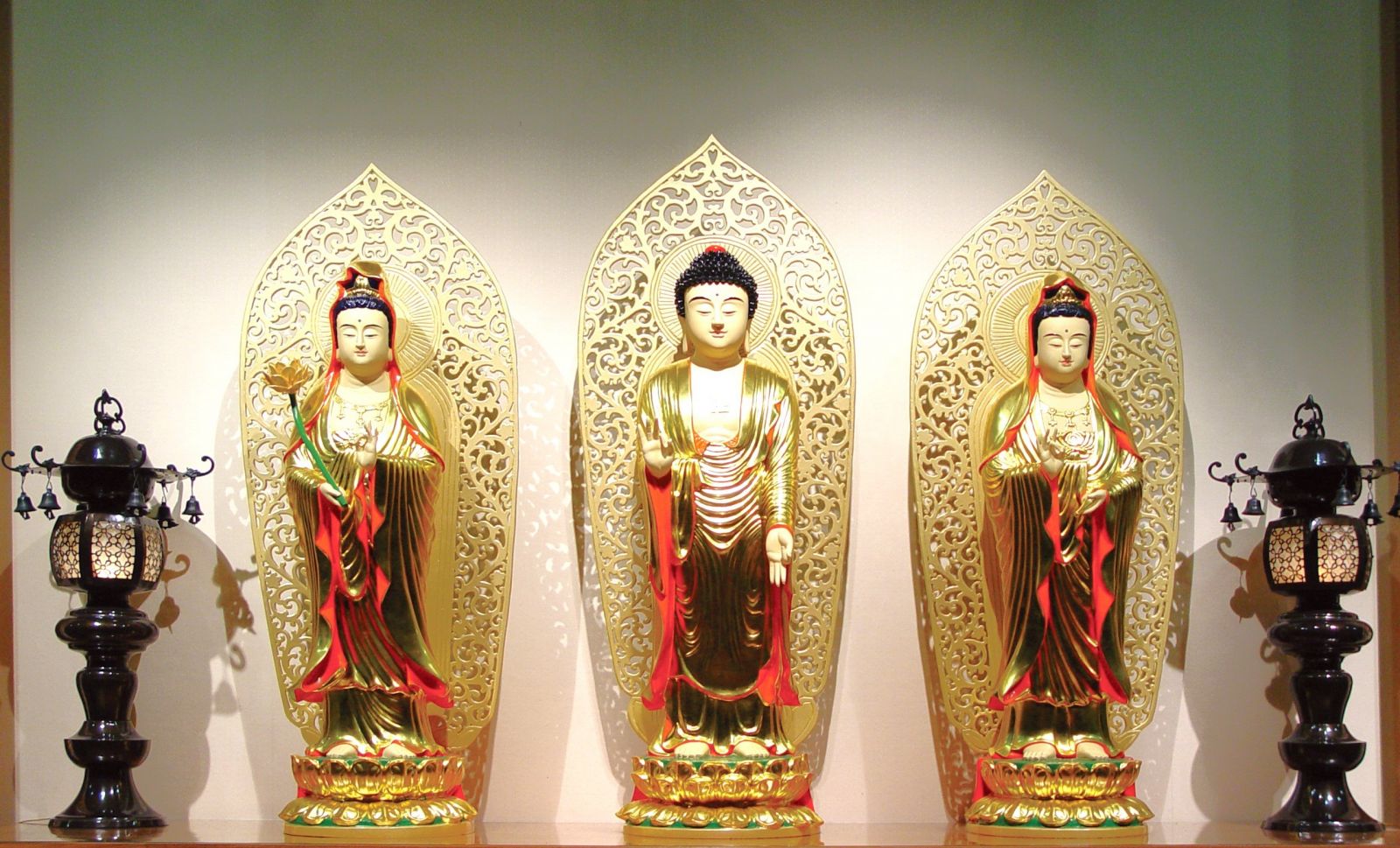Special Topics
Three Saints of the Western Pure Land
An introduction to combinations of Buddhist statues – one buddha flanked by two bodhisattvasThree Saints of the Western Pure Land – Guides to the World of Ultimate Bliss
As narrated in the Longer Sukhāvatīvyūha Sūtra, in ten trillion Buddha lands from the west of the Sahā World, there is Western World of Ultimate Bliss. It is a pure Buddha land accomplished by Amitābha Buddha through the fulfillment of 48 great vows made during his practice in the causal ground. The Shorter Sukhāvatīvyūha Sūtra (or Amitabha Sutra) depicts the scene of Western World of Ultimate Bliss as follows: there is the pool of seven jewels filled with the water of eight excellent qualities; everywhere in this world is bright; there are jeweled trees and lotus flowers in full bloom. All sentient beings here spontaneously manifest within lotus flowers. After seeing the Buddha and hearing the Dharma, they will acquire the patient acceptance based on cognizance of nonarising of phenomena (anutpattika-dharma-kṣānti). Moreover, they will never fall into the three unfortunate destinies of existence, and will surely attain Buddhahood in the future.
According to the Shorter Sukhāvatīvyūha Sūtra, if one can chant the name of Amitābha Buddha with undistracted concentration, together with making offerings and giving in daily life, and developing enough virtuous karmic roots (Sanskrit: Kusala-mula,) and virtues, one will be able to be reborn in the Western Pure Land. Also, the Longer Sukhāvatīvyūha Sūtra mentions Amitābha Buddha's 48 vows. Among these, the eighteenth vow states that due to the power of the Buddha's vow, only ten recitations of the Buddha's name are needed for one to be reborn in the Western Pure Land. At the end of one's life, Amitābha Buddha, along with two flanking bodhisattvas – Avalokiteśvara Bodhisattva and Mahāsthāmaprāpta Bodhisattva – will come to ferry him to his pure land with a lotus platform in hand. Thus, they are known as the "Three Saints of the Western Pure Land" or the "Triad of Amitābha."

Amitābha Buddha
Amitābha, or Amitāyus in Sanskrit, means "Infinite Light" and "Infinite Life" respectively. As the principal figure of the Three Saints of the Western Pure Land, the statue of Amitābha Buddha often comes in a standing position with a fearlessness gesture (abhaya mudrā), and a generosity gesture (varada mudrā), which represent his aspiration to walk towards the suffering sentient beings to help them be free from the sea of suffering. Avalokiteśvara Bodhisattva and Mahāsthāmaprāpta Bodhisattva stand on the left and right side of the Buddha to lead those approaching the end of life to the World of Ultimate Bliss. While in sitting posture, the statue of Amitābha Buddha often appears in the lotus pose on a lotus seat, holding an abhaya mudrā and a varada mudrā, which respectively represent the tranquility and compassion of Amitābha Buddha. This image helps to strengthen the viewers' faith in the Western Pure Land.
Guanyin Bodhisattva (Avalokiteśvara)
Avalokiteśvara Bodhisattva, the flanking bodhisattva on Amitābha Buddha's left side, has a profound karmic affinity with the Sahā World. Furthermore, according to the Longer Sukhāvatīvyūha Sūtra and the Assurance of Avalokiteśvara's Future Enlightenment Sutra (觀世音菩薩授記經), he is the bodhisattva limited to only one more birth (eka-jāti-pratibaddha) in the Western World of Ultimate Bliss. After the nirvana of Amitābha Buddha, Avalokiteśvara Bodhisattva will succeed to the Buddha's position. Therefore, in Buddhist art, the Buddha on Avalokiteśvara Bodhisattva's crown is Amitābha Buddha. Statues of Avalokiteśvara often take the form of a figure holding a willow twig, representing the great compassion that spreads as the Bodhisattva sprinkles purifying water to help sentient beings.
Mahāsthāmaprāpta Bodhisattva
Mahāsthāmaprāpta Bodhisattva is the flanking attendant by Amitābha Buddha's right side. According to the Amitayurdhyana Sutra, he and Avalokiteśvara Bodhisattva are identical in physique and attire. They respectively represent wisdom and compassion that practitioners strive to attain. Thus, statues of Mahāsthāmaprāpta Bodhisattva often appear with a lotus flower in hand and a celestial crown with a precious vase in it to symbolize wisdom. While Avalokiteśvara Bodhisattva shines the light of compassion on all sentient beings, Mahāsthāmaprāpta Bodhisattva illuminates the darkness using the light of wisdom. Together, they guide all sentient beings away from the suffering of the three unfortunate destinies.
Related articles:
Buddhas and Bodhisattvas in the Pure Lands
The Triad of Sakyamuni Buddha
Three Saints of the Ghanavyūha
Three Saints of the Western Pure Land
Three Saints of the Eastern Pure Land
Buddhas of the Three Times
One Buddha Flanked by Two Disciples
Resource: Issue 402 of Humanity Magazine, Dharma Drum Publishing Corporation
Translation: Sinag-ling Li (李祥苓)
Editing: Keith Brown, 可馨
